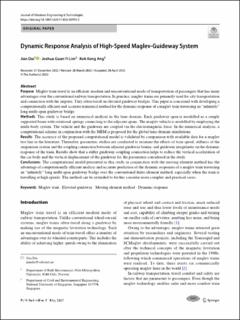Dynamic Response Analysis of High‑Speed Maglev‑Guideway System
Peer reviewed, Journal article
Published version
Permanent lenke
https://hdl.handle.net/11250/3071745Utgivelsesdato
2023Metadata
Vis full innførselSamlinger
Originalversjon
https://doi.org/10.1007/s42417-023-00995-5Sammendrag
Purpose Maglev train travel is an efcient, modern and unconventional mode of transportation of passengers that has many advantages over the conventional railway transportation. In practice, maglev trains are primarily used for city transportation and connection with the airports. They often travel on elevated guideway bridges. This paper is concerned with developing a computationally efcient and accurate numerical method for the dynamic response of a maglev train traversing an “infnitely” long multi-span guideway bridge.
Methods This study is based on numerical analysis in the time domain. Each guideway span is modelled as a simply supported beam with rotational springs connecting to the adjacent spans. The maglev vehicle is modelled by employing the multi-body system. The vehicle and the guideway are coupled via the electromagnetic force. In the numerical analysis, a computational scheme in conjunction with the MEM is proposed for the global time-domain simulations.
Results The accuracy of the proposed computational model is validated by comparison with available data for a maglev test line in the literature. Thereafter, parametric studies are conducted to examine the efects of train speed, stifness of the suspension system and the coupling connection between adjacent guideway beams, and guideway irregularity on the dynamic response of the train. Results show that a stifer guideway coupling connection helps to reduce the vertical acceleration of the car body and the vertical displacement of the guideway for the parameters considered in the study.
Conclusions The computational model presented in this study in conjunction with the moving element method has the advantage of computationally efcient analysis and accurate prediction of the dynamic responses of a maglev train traversing an “infnitely” long multi-span guideway bridge over the conventional fnite-element method, especially when the train is travelling at high speeds. The method can be extended to further consider more complex and practical cases.

